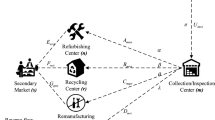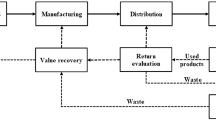Abstract
This paper aims at multi-objective performance assessment and optimization of a multi-period two-echelon supply chain consisting of a supplier and a manufacturer. On the basis of the assessment system of the supply-chain operations reference model, the supply chain’s performance is investigated with respect to costs, assets, agility, reliability and responsiveness. First, methods to quantify these five performance attributes are put forward. Then a multi-objective mathematical programming model is developed for production decision making of components and products so that the supply chain’s performance frontier formed with Pareto efficient performance values can be achieved. Thereafter a simple augmented \(\epsilon \)-constraint method is proposed for searching for all Pareto efficient solutions of the multi-objective mathematical programming problem. Finally, efficiency of the method is demonstrated with a numerical example and a sensitivity analysis is implemented to reveal effects of capacity expansion on supply chains’ performance.



Similar content being viewed by others
References
Abdelaziz FB (2007) Multiple objective programming and goal programming: new trends and applications. Eur J Oper Res 177:1520–1522
Akyuz GA, Erkan TE (2010) Supply chain performance measurement: a literature review. Int J Prod Res 48:5137–5155
Alves MJ, Clímaco J (2007) A review of interactive methods for multiobjective integer and mixed-integer programming. Eur J Oper Res 180:99–115
Alves MJ, Costa JP (2009) An exact method for computing the nadir values in multiple objective linear programming. Eur J Oper Res 198:637–646
Angerhofer BJ, Angelides MC (2006) A model and a performance measurement system for collaborative supply chains. Decis Support Syst 42:283–301
Beamon BM (1999) Measuring supply chain performance. Intl J Oper Prod Manag 19:275–292
Beamon BM, Chen VCP (2001) Performance analysis of conjoined supply chains. Int J Prod Res 39: 3195–3218
Blanco V (2011) A mathematical programming approach to the computation of the omega invariant of a numerical semigroup. Eur J Oper Res 215:539–550
Branke J, Deb K, Miettinen K, Słowiński R (eds) (2008) Multiobjective optimization: interactive and evolutionary approaches. Springer, Berlin
Brewer PC, Speh TW (2000) Using the balanced scorecard to measure supply chain performance. J Bus Logist 21:75–93
Chan FTS (2003) Performance measurement in a supply chain. Int J Adv Manuf Technol 21:534–548
Chen MC, Yang T, Li HC (2007) Evaluating the supply chain performance of IT-based inter-enterprise collaboration. Inf Manag 44:524–534
Chinchuluun A, Pardalos PM (2007) A survey of recent developments in multiobjective optimization. Ann Oper Res 154:29–50
Ehrgott M, Gandibleux X (eds) (2002) Multiple criteria optimization: state of the art annotated bibliographic surveys. Kluwer, Boston
Ehrgott M, Tenfelde-Podehl D (2003) Computation of ideal and nadir values and implications for their use in MCDM methods. Eur J Oper Res 151:119–139
Estampe D, Lamouri S, Paris JL, Brahim-Djelloul S (2013) A framework for analysing supply chain performance evaluation models. Int J Prod Econ 142:247–258
Farahani RZ, Elahipanah M (2008) A genetic algorithm to optimize the total cost and service level for just-in-time distribution in a supply chain. Int J Prod Econ 111:229–243
Florian M, Klein M (1971) Deterministic production planning with concave costs and capacity constraints. Manag Sci 18:12–20
Gunasekaran A, Kobu B (2007) Performance measures and metrics in logistics and supply chain management: a review of recent literature (1995–2004) for research and applications. Int J Prod Res 45: 2819–2840
Gunasekaran A, Patel C, Tirtiroglu E (2001) Performance measures and metrics in a supply chain environment. Int J Oper Prod Manag 21:71–87
Gunasekaran A, Patel C, McGaughey RE (2004) A framework for supply chain performance measurement. Int J Prod Econ 87:333–347
Haimes YY, Lasdon LS, Wismer DA (1971) On a bicriterion formulation of the problems of integrated system identification and system optimization. IEEE Trans Syst Man Cybern 1:296–297
Isermann H, Steuer RE (1988) Computational experience concerning payoff tables and minimum criterion values over the efficient set. Eur J Oper Res 33:91–97
Kaplan RS, Norton DP (1992) The balanced scorecard-measures that drive performance. Harv Bus Rev 70:71–99
Klein D, Hannan E (1982) An algorithm for the multiple objective integer linear programming problem. Eur J Oper Res 9:378–385
Li D, O’Brien C (1999) Integrated decision modelling of supply chain efficiency. Int J Prod Econ 59:147–157
Li S, Rao SS, Ragu-Nathan TS, Ragu-Nathan B (2005) Development and validation of a measurement instrument for studying supply chain management practices. J Oper Manag 23:618–641
Li L, Su Q, Chen X (2011) Ensuring supply chain quality performance through applying the SCOR model. Int J Prod Res 49:33–57
Liu S, Papageorgiou LG (2012) Multiobjective optimisation of production, distribution and capacity planning of global supply chains in the processindustry, Omega (in press)
Lockamy A, McCormack K (2004) Linking SCOR planning practices to supply chain performance: an exploratory study. Int J Oper Produ Manag 24:1192–1218
Mavrotas G (2009) Effective implementation of the \(\epsilon \)-constraint method in Multi-Objective Mathematical Programming problems. Appl Math Comput 213:455–465
Özlen M, Azizoǧlu M (2009) Multi-objective integer programming: a general approach for generating all non-dominated solutions. Eur J Oper Res 199:25–35
Ozlen M, Burton BA (2011) Multi-objective integer programming: an improved recursive algorithm (Online). http://arxiv.org/PS_cache/arxiv/pdf/1104/1104.5324v1.pdf
Oztemel E, Tekez EK (2009) Interactions of agents in performance based supply chain management. J Intell Manuf 20:159–167
Persson F, Olhager J (2002) Performance simulation of supply chain designs. J Prod Econ 77:231–245
Ramdas K, Spekman RE (2000) Chain or shackles: understanding what drives supply-chain performance. Interfaces 30:3–21
Reeves GR, Reid RC (1988) Minimum values over the efficient set in multiple objective decision making. Eur J Oper Res 36:334–338
Richter K (1986) The two-criterial dynamic lot size problem. Syst Anal Model Simul 3:99–105
Sabri EH, Beamon BM (2000) A multi-objective approach to simultaneous strategic and operational planning in supply chain design. Omega 28:581–598
Schmenner RW, Swink ML (1998) On theory in operations management. J Oper Manag 17:97–113
Schweigert D, Neumayer P (1997) A reduction algorithm for integer multiple objective linear programs. Eur J Oper Res 99:459–462
Shepherd C, Günter H (2006) Measuring supply chain performance: current research and future directions. Int J Prod Perform Manag 55:242–258
Supply-Chain Council (2010) Supply-Chain operations reference-model (online). http://www.supply-chain.org
Sylva J, Crema A (2004) A method for finding the set of non-dominated vectors for multiple objective integer linear programs. Eur J Oper Res 158:46–55
Sylva J, Crema A (2007) A method for finding well-dispersed subsets of non-dominated vectors for multiple objective mixed integer linear programs. Eur J Oper Res 180:1011–1027
Teghem J, Kunsch PL (1986) A survey of techniques for finding efficient solutions to multi-objective integer linear programming. Asia-Pac J Oper Res 3:95–108
Thonemann UW, Bradley JR (2002) The effect of product variety on supply-chain performance. Eur J Oper Res 143:548–569
Wagner HM, Whitin TM (1958) Dynamic version of the economic lot size model. Manag Sci 5:89–96
Wang WYC, Chan HK, Pauleen DJ (2010) Aligning business process reengineering in implementing global supply chain systems by the SCOR model. Int J Prod Res 48:5647–5669
Zangwill WI (1966) A deterministic multi-period production scheduling model with backlogging. Manag Sci 13:105–119
Author information
Authors and Affiliations
Corresponding author
Appendices
Appendix A: Proof of Proposition 1
Proof
First, we observe that the set of feasible solutions of the three-dimensional model and that of the five-dimensional model are identical. Suppose \(x^*\) is an efficient solution of the three-dimensional model. Then \(x^*\) must be also a feasible solution of the five-dimensional model. Suppose it is not an efficient solution of the five-dimensional model, then there must exist an efficient solution of the five-dimensional model, e.g. \(x^{**}\), whose corresponding non-dominated solution (\(TC^{SC}(x^{**}),\, A^{SC}(x^{**}),\, F^{SC}(x^{**}),\, POF^{SC}(x^{**}),\, BO^{SC}(x^{**})\)) dominates (\(TC^{SC}(x^*), A^{SC}(x^*),\, F^{SC}(x^*),\, POF^{SC}(x^*),\, BO^{SC}(x^*)\)). This means that constraints \(TC^{SC}(x^{**}) \le TC^{SC}(x^*),\, A^{SC}(x^{**}) \le A^{SC}(x^*),\, F^{SC}(x^{**}) \ge F^{SC}(x^*),\, POF^{SC}(x^{**}) \ge POF^{SC}(x^*)\) and \(BO^{SC}(x^{**}) \le BO^{SC}(x^*)\) hold with at least one strict inequality. As a result, (\(a_1*TC^{SC}(x^{**}) + a_2*A^{SC}(x^{**}),\, F^{SC}(x^{**}),\, b_1*(\sum _{t=1}^Td_t - POF^{SC}(x^{**})) + b_2*BO^{SC}(x^{**})\)) dominates (\(a_1*TC^{SC}(x^*) + a_2*A^{SC}(x^*),\, F^{SC}(x^*)\), \( b_1*(\sum _{t=1}^Td_t - POF^{SC}(x^*)) + b_2*BO^{SC}(x^*)\)). That is to say, the solution \(x^*\) does not belong to the set of efficient solutions of the three-dimensional model which contradicts our assumption. So \(x^*\) must be an efficient solution of the five-dimensional model. On the other hand, when all non-dominated solutions of the five-dimensional model are aggregated a-posteriori, among the results obtained some solutions may be dominated. It means that some efficient solutions of the five-dimensional model are not efficient solutions of the three-dimensional model. So the set of efficient solutions of the three-dimensional model is a proper subset of the set of efficient solutions of the five-dimensional model. \(\square \)
Appendix B: Proof of Theorem 1
Since it is easy to observe the efficiency and effectiveness of the extension to algorithm acceleration with early exit, here we mainly concentrate on the proof of the efficiency and effectiveness of the acceleration algorithm with bouncing steps. Without loss of generality, let us take \(e_{POF}\) as an example to discuss the problem of bouncing loop-control variables forward. Suppose current grid values of \(e_A,\, e_F\) and \(e_{POF}\) are \(e_A^0,\, e_F^0\) and \(e_{POF}^0\), respectively. The minimum of \(POF^{SC}(q^s, q^m)\), the relatively worst value, is \(RWV_{POF}^0\) after the following series of optimization models are solved when \(e_{BO}\) moves from \(BO^{nad}\) to \(BO^{opt}\).
In the acceleration algorithm with bouncing steps, \(e_{POF}\) is set to be \(RWV_{POF}^0 + 1\) immediately after all above models are solved if \(RWV_{POF}^0 < POF_{max}\). Obviously, if \(RWV_{POF}^0 = e_{POF}^0,\, e_{POF}\) is \(e_{POF}^0+1\) which exactly is what other \(\epsilon \)-constraint based methods do. So in the following discussion we mainly consider \(RWV_{POF}^0 > e_{POF}^0\). In this situation the following series of models are not solved with the SAUGMECON method when the acceleration algorithm with bouncing steps is utilized.
We will prove that the series of models in (41) don’t need to be solved because of equivalence of the model in (41) and its counterpart in (40). Let us consider a concrete model (42) in (40) and a concrete model (43) in (41).
The following lemma holds:
Lemma 1
An optimal solution of the model (43) must be an optimal solution of the model (42).
Proof
Suppose that the optimal solution of the model (42) is {\(TC_1^*,\, A_1^*,\, F_1^*,\, POF_1^*, BO_1^*\)} and the optimal solution of the model (43) is {\(TC_2^*,\, A_2^*,\, F_2^*,\, POF_2^*,\, BO_2^*\)}. It is obvious that {\(TC_2^*,\, A_2^*,\, F_2^*,\, POF_2^*,\, BO_2^*\)} is a solution of the model (42) since \(POF_2^* \ge e_{POF}^{^{\prime }} > e_{POF}^0\). If it is not an optimal solution of the model (42), we will have the following inequality:
On the other hand, \(POF_1^* \ge RWV_{POF}^0\) since \(RWV_{POF}^0\) is the minimum of \(POF^{SC}(q^s, q^m)\) obtained by solving the series of models in (40). Given \(e_{POF}^{^{\prime }} \le RWV_{POF}^0\), we have \(POF_1^* \ge e_{POF}^{^{\prime }}\). So {\(TC_1^*,\, A_1^*,\, F_1^*,\, POF_1^*,\, BO_1^*\)} is also a solution of the model (43). Since the optimal solution of the model (43) is {\(TC_2^*,\, A_2^*,\, F_2^*,\, POF_2^*,\, BO_2^*\)}, the following inequality holds:
Apparently, inequalities (44) and (45) contradict with each other. So the optimal solution of the model (43) must be the optimal solution of the model (42). \(\square \)
Similarly, we can obtain the following lemma:
Lemma 2
An optimal solution of the model (42) must be an optimal solution of the model (43).
Based on the above two lemmas, a conclusion can be drawn that the optimal solution of the model (42) and the optimal solution of the model (43) are totally the same. Since the model (42) has been solved, there is no need to solve the model (43). For the same reason, the series of models in (41) don’t need to be solved. As a result, the number of single objective optimization models that need to be solved with the SAUGMECON method is reduced greatly. \(\square \)
Rights and permissions
About this article
Cite this article
Zhang, W., Reimann, M. Towards a multi-objective performance assessment and optimization model of a two-echelon supply chain using SCOR metrics. Cent Eur J Oper Res 22, 591–622 (2014). https://doi.org/10.1007/s10100-013-0294-7
Published:
Issue Date:
DOI: https://doi.org/10.1007/s10100-013-0294-7




